
 |
|
#11
|
||||
|
||||
|
I heard from Professor Kajiura from FAU in regard to the Blacktip migration. He had been traveling extensively in recent weeks. The professor offered a few comments in addition to the information provided by his graduate student, Shari Tellman. He added that between the close proximity of the Gulf Stream to shore and presence of calm water allows the blacktips to mass at times close to shore. He also observed that the presence of large numbers of blacktips nearshore in Palm Beach County may be a little late this year due to the unusually warm winter conditions so far this year.
Their important research has run out of funding and so will end this spring. This is unfortunate as there is still more to learn about this important shark species and the migration. Continued research might even impact the occurrence of attacks such as suffered by young Cole Taschman in time.
__________________
FKA, Inc. transcribed by: Rick Iossi |
|
#12
|
||||
|
||||
 From: KRISTA SIMPSON via http://www.tcpalm.com/ An update on the migration from the Sunsentinel. I believe this is the southerly migration of spinner sharks which precedes the more well publicized northerly movement in the spring. The article doesn't discuss larger sharks such as bulls, tigers and hammerheads which escort the migration which reportedly were responsible for Steve Schafer's fatal accident while kiteboarding off Stuart, FL in the spring migration of 2010..  From: http://www.wptv.com/ "By David Fleshler, Sun Sentinel November 30, 2013 Thousands of blacktip and spinner sharks will swim into South Florida in the next few weeks in an annual migration that yields spectacular aerial videos and occasional beach closures." "The sharks swim as far south as southern Broward or northern Miami-Dade County, said Stephen Kajiura, associate professor of biology at FAU, who has studied the migration. They head north in March, reaching as far as North Carolina. Scientists say the danger to people is low, despite scary aerial videos that show vast swarms of sharks within yards of clueless swimmers. Blacktips and spinners, which typically reach lengths of five or six feet, eat mullet, grouper, snook and other fish, nothing as large as a human being." More at: http://www.sun-sentinel.com/news/pal...,3721824.story More about the migration from http://www.tcpalm.com at : http://www.tcpalm.com/news/2013/oct/...t/?partner=RSS  From: Spinner off Juno Pier, Photo: Nadja Neptune via http://www.wptv.com/ Channel 5 has an article on how to tell the difference between spinner and blacktip sharks, both which can be present in quantity during the migration. They reported that the spinner shark has a black tip on the corner of their pectoral fin while ironically, blacktip sharks do not. More at: http://www.wptv.com/dpp/sports/recre...the-difference .
__________________
FKA, Inc. transcribed by: Rick Iossi Last edited by ricki; 12-01-2013 at 04:45 AM. |
|
#13
|
||||
|
||||
|
Heads up, the northbound blacktip shark migration is back for 2014.
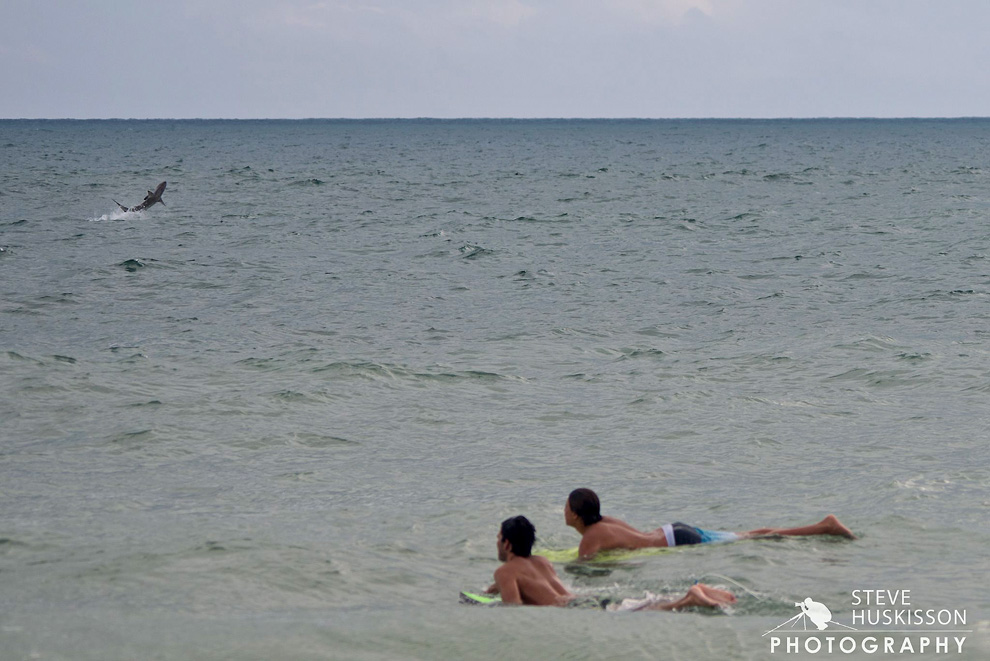 Photographer Steve Huskisson posted the following image from Juno Beach and comments on his Facebook page today. "Waves, surfers, paddleboards and sharks... Yes sharks. Headed over to walkway 36 and met up with Lori Griffith and Jeffrey Barron Biege to shoot some surfing. The Spinner Sharks were plentiful and I was content on shooting surfers until Lori said "get a shot with a shark in it..." Last time I take on that challenge. I stood, fixated on the ocean beyond the surfers waiting and watching shark after shark to my left and right jumping. Captured plenty of after splashes of the sharks. Finally, one decided to jump where I was waiting. Here you go Lori, your shark..... No photoshop, just patience and a lot of shutter clicks of missed sharks. More of today's surf & paddle boards from Juno Beach, Coral Cove and Walkway 36 to come. " https://www.facebook.com/shuskisson Some related comments from the Sunsentinel: "South Florida Is About To Be Swarmed By Sharks Sun Sentinel | By David Fleshler Posted: 11/28/2013 3:55 am EST | Updated: 01/27/2014 5:59 am EST Thousands of blacktip and spinner sharks will swim into South Florida in the next few weeks in an annual migration that yields spectacular aerial videos and occasional beach closures. Up to 15,000 have been counted on a single day off Palm Beach County by scientists from Florida Atlantic University, and these just represent the ones visible from one flight along the coast. Like birds and manatees, the sharks come south for the winter, arriving in December and January, with numbers peaking in late January and early February. "When they're there, you can walk on them," said Josh Jorgensen, of Singer Island, director of the Blacktip Challenge, a five-day catch-and-release tournament along Florida's east coast that tags sharks for scientists. "I remember one time last year there must have been 500 that swam by in an hour, endless blacktips. They were 20 or 30 feet off the beach." The sharks swim as far south as southern Broward or northern Miami-Dade County, said Stephen Kajiura, associate professor of biology at FAU, who has studied the migration. They head north in March, reaching as far as North Carolina. Scientists say the danger to people is low, despite scary aerial videos that show vast swarms of sharks within yards of clueless swimmers. Blacktips and spinners, which typically reach lengths of five or six feet, eat mullet, grouper, snook and other fish, nothing as large as a human being. "Those sharks are 100 or 200 yards away from thousands of bathers and they show no interest in them at all," said Brent Winner, research scientist for the Florida Fish and Wildlife Conservation Commission" Continued at: http://www.huffingtonpost.com/2013/1...n_4353745.html .
__________________
FKA, Inc. transcribed by: Rick Iossi |
|
#14
|
||||
|
||||
 At the public beach at the south end of Singer Island I've seen about 10 black tip sharks jump in as many minutes. They are too far offshore to catch with an iPhone unfortunately. They have closed the public beach to swimming. They took about a 20 minute break and the started spinning again. I think I saw three go together at the same time. If they are trying to panic and stun bait, it makes sense to go in groups. A guy who works at a concession on the beach there said the sharks had been visible for about four days so far this season at Singer Island.
__________________
FKA, Inc. transcribed by: Rick Iossi Last edited by ricki; 02-09-2014 at 09:26 PM. |
|
#15
|
||||
|
||||
 http://www.towleroad.com/2008/07/jumping-the-sha.html GRAPHIC INJURY PHOTOS FOLLOW The blacktip sharks migrate south in the late fall to Broward and Miami-Dade Counties and then head back north to the waters off the Carolinas in January to April to give birth. For some reason many of the incidents you hear about occur during the northerly migration. A surfer was bitten on the foot near the Deerfield Beach Pier, apparently by a five foot spinner or blacktip shark. The surfer didn't notice evidence of sharks in the area and was about 50 yards off the beach when his foot was struck. A five foot spinner shark then launched out of the water nearby spinning. He received 50 stitches to close the lacerations.   More at: http://www.sun-sentinel.com/local/br...019-story.html Spinner and blacktip sharks aren't fond of the way we taste apparently, given the frequency in Florida of non-fatal, bite and run attacks like this. Still, when bait are running particularly during some of the larger migrations like the bluefish at present, sharks are likely following along in numbers. The shark may strike, decide it wants something fishier and moves on. The severity of the damage depends in large measure what is bitten and how intensely. Then there are the larger sharks which may prey upon the often smaller spinner and blacktip sharks following the bait migrations as well like hammerheads, tigers and bull sharks. The bite radius alone even in the case of a bite and run attack with these larger and at times more aggressive species can be far more dangerous given the amount of tissue damage that may be involved. Kiteboarder Steve Schafer died as a result of severe vascular wounds suffered off Stuart, FL in 2010 likely from a bull or tiger shark bite during the blacktip/spinner migration.  No joy for me at Boynton Inlet although the birds and fishermen seem to be having a good time. Like many kiters I have been taking full advantage of this great first bout of wind we've been having in South Florida. Yesterday I was going to head off the Boynton Inlet but was dismayed to see a mass of seagulls and bait clouding the water right at the mouth of the cut. Lots of fishermen were pulling in bluefish as fast as they could cast their lines out. Looked like shark sign to me big time, so I headed further south. I stopped at a park almost a mile south and spoke to a kiter who had just come off the water. He said the bluefish were pretty thick off there being chased by some monster tarpon. He didn't see any sharks but unless they are spinning you often never do but they are likely still there.  Kiting last night off Hillsboro Inlet. Ironically, that could be a small shark about 40 ft. ahead of me slightly off to the right on a diagonal. I have picked up sharks before when I ran close to the north jetty and caught them on the kite camera. I went all the way to Pompano and had a session seeing little bait except for a small pocket inside the south jetty of Hillsboro Inlet. Still, there are sharks frequently around all inlets and this one is no exception. I just didn't see a lot of bait, feeding birds, etc., yet. Still, as the photo below shows sharks can swim along at anytime in these waters. Fortunately, they usually ignore us. I tried to photograph them in the water but they always swam off out of visible range. Perhaps in the heat of chasing migrating bait they may get a bit worked up. 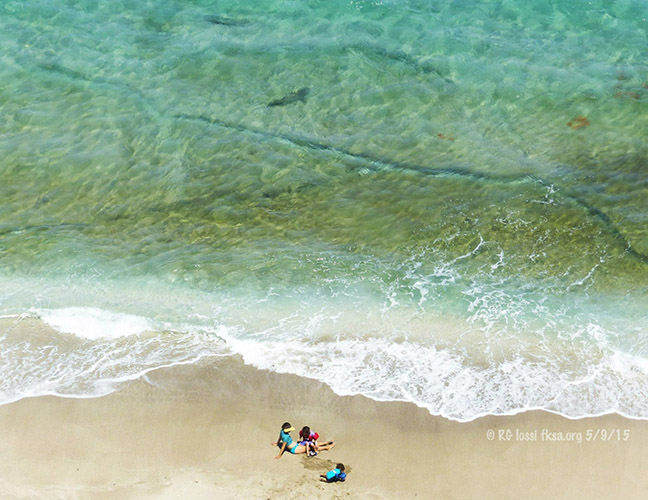 So, have a care out there. Avoid bait being worked evidenced by jumping fish, sea birds, spinning sharks, etc.. The reality is that attacks can occur outside of such areas. All you can do is use common sense to try to reduce the odds. Staying out of the water and on plane may help. Most of our problems in past years seemed to have happened when kiters are in the water and off their boards.
__________________
FKA, Inc. transcribed by: Rick Iossi Last edited by ricki; 10-21-2015 at 04:32 PM. |
|
#16
|
||||
|
||||
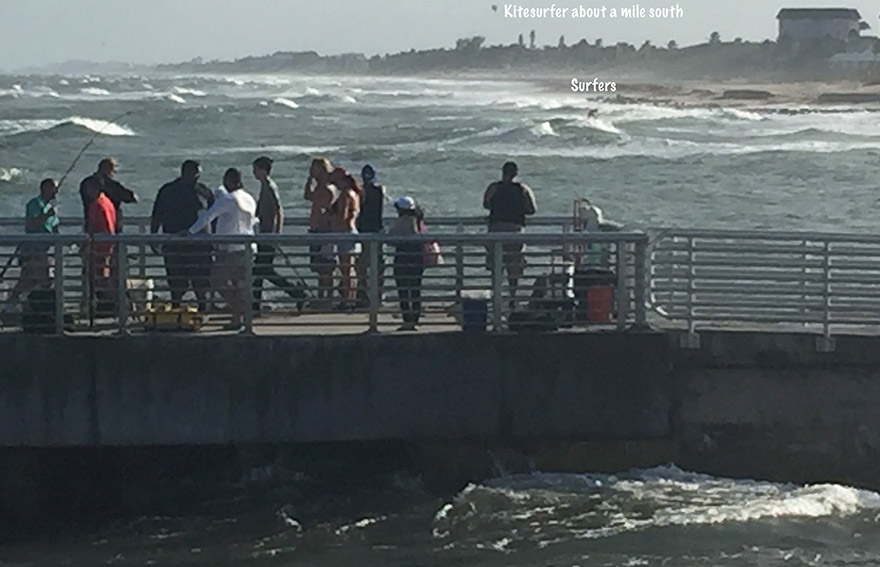 Here is an image looking south from the north jetty of the Boynton Inlet over the south jetty crowded with fishermen pulling up bluefish. You can see a small, fairly tightly packed group of surfers nearshore to the south. They were within about a 100 yards of the working birds and jumping bluefish. As tight as the surfers were packed, makes you wonder if they were staying closer together as a precaution against or in case of shark attack? You can make out a kite almost a mile south. This is the guy I later spoke to in the parking lot as I headed south myself. I ended up driving all the way down to Pompano Beach to kite. I didn't see any obvious shark sign or many fishermen either. Despite that four miles north of where I went kiting a surfer was bitten a little earlier that same day. I found out about the attack the afternoon of the following day. The bluefish are moving south along with the predators that dog the school until late winter, early spring when the spinners/blactips will head north again. 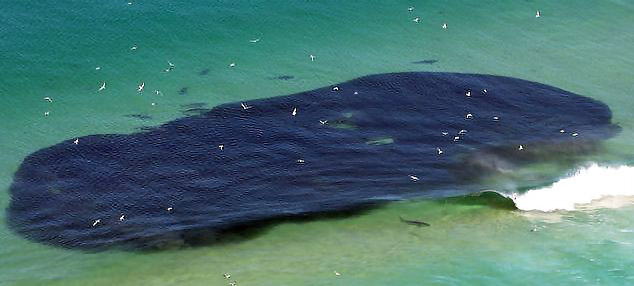 From http://www.dailymail.co.uk/news/arti...ne-surfer.html I went looking for some good birds working schools of bait shots and came across this one from the Daily Mail. Those guys do a lot of good photojournalism. This was in Australia but the scene may not be much different here at time say with the blacktip/spinner shark migration. You can see the mass of the schooling fish, the overflying and diving birds and the holes the sharks create in the schools. Other larger predators like tarpon and jacks can create holes as well. 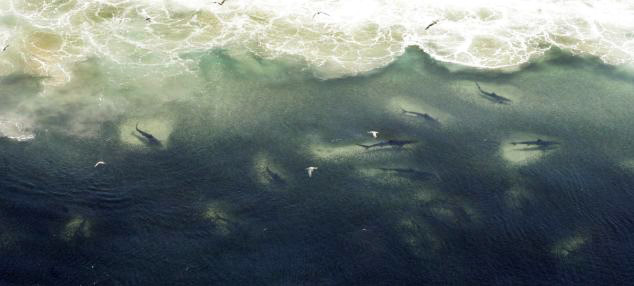 The bait and sharks themselves can come very close to shore. The sharks can be seen in bare inches of water flapping among bait on the sand at times. So, just because you are close to shore don't assume sharks can't work in close too. Again, take out the schools of fish particularly those been aggressively fed upon and things can be more sedate with the sharks. They may swim off in fact if you come close to them, in SE Florida, much of the time. This may or may not be the case elsewhere particularly if they are distracted by hunting prey, seals, etc.. 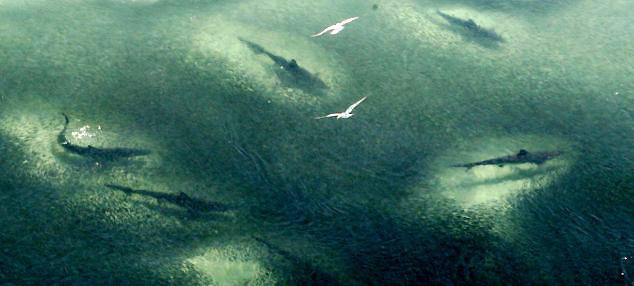 That is a lot of sharks but at times we may have similar groupings around Florida. The fish school may be a lot easier to see than the sharks from the ground surface. Not all sharks jump that much or do the classic dorsal fin glide at the surface so popular on TV. Usually, it is hard to see them, you just assume under certain circumstances that they may be there. The Daily Mail article made one amusing statement; "The rules are dead simple and every surfer knows them. Don't go out there when there are bait fish around because there will be plenty of sharks in the area who are ready to eat more than just the fish." This may be the case in Australia, maybe, where the shark attacks can result in severe injury and fatality rate are much higher than say in Florida. We have far more attacks but few fatalities by comparison. Our surfers seem more inclined to ignore obvious shark sign and take their bites. Hopefully, the bites will be minor with no fatalities or permanent disfigurements. The later can happen at times but forewarned is forearmed. I recommend avoiding schools of fish particularly those being worked by predators for all the reasons given above.
__________________
FKA, Inc. transcribed by: Rick Iossi Last edited by ricki; 10-22-2015 at 10:22 AM. |
|
#17
|
||||
|
||||
 I finally made it off Boynton Beach Inlet tonight. It looked clear from the livecam at my office unlike in the last couple of days. By the time I got down near the end of the day, there was a ton of fishermen, a number of sea gulls flying around the area. I thought, not again. I walked down for a closer look and to talk to some of the fishermen. They said they hadn't seen any spinners (jumping sharks) nor thick patches of bluefish school. Looking at the birds they were grabbing what they could from the fishermen as opposed from the water, so I headed out. It was a nice session with good wind, waves and sun. I didn't see any sharks, jumping or otherwise, jumping bait or plunging sea birds. I had a couple of GoPros on my kite making spotting shallow sharks fairly easy. None showed up there either. I have little doubt sharks were in the area as always but they seemed to be in a low key mood. So, there was risk of a negative encounter, just not a high one this time in my view from what I had learned.  .
__________________
FKA, Inc. transcribed by: Rick Iossi |
|
#18
|
||||
|
||||
|
Migration seems to be back, recent aerial video at: https://www.facebook.com/33042648382...5903037944124/
"The aerial survey flight yesterday revealed that large numbers of sharks have now arrived in southeast Florida. This video clip was captured off Palm Beach, just south of the Palm Beach Inlet. Looking forward to tagging some blacktips tomorrow. This is a greatly downsampled clip; the original 4K video is much clearer."
__________________
FKA, Inc. transcribed by: Rick Iossi |
|
#19
|
||||
|
||||
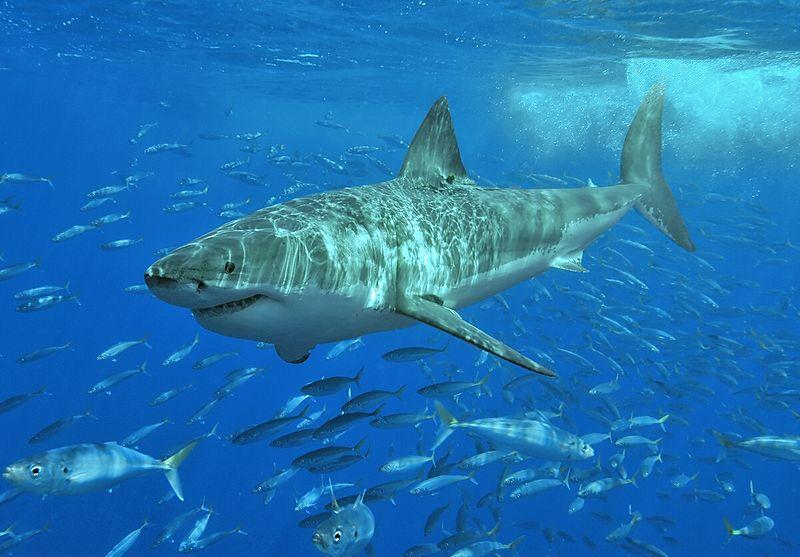 NPR interviewed local shark researcher, Dr. Stephen M. Kajiura of FAU. " Sharks, Sharks, Everywhere By Luis Hernandez • 14 hours ago There are literally tens of thousands of sharks that come down and spend the winter right off our beaches here in Southeast Florida. Add to that the fact that Florida beaches are very popular for tourists and locals. Those are the ingredients that have made Florida the world's leader in shark attacks. Dr. Stephen M. Kajiura of the Elasmobranch Research Laboratory, Biological Sciences, Florida Atlantic University Blacktip sharks are a medium sized shark. They’re maybe just about six feet long at the most. They are primarily fish eaters, and they will come down, spend the winter down here (South Florida) where the temperature is preferred. And then they'll follow that preferred temperature up the coast in the spring. So they migrate farther north and spend the summers off the Carolinas before coming back here again the next year. Carcharhinus melanopterus: blacktip reef sharks are grey or brown on the dorsal area and white on the ventral. The tips of each of its fins are black with a lighter band lying just below the black Credit https://bioweb.uwlax.edu/bio203/f201...adaptation.htm / Organismal Biology at University of Wisconsin - La Crosse I'd imagine as a researcher that you spend a lot of your time up close with underwater species. Why did you want to get this bird's eye view of blacktip sharks? Well, for many years I would get inquiries from the local media saying that their news helicopters had seen large numbers of the sharks (from above). I told them all it is is a migration that happens every year. No big deal. But when I had the opportunity to do the flying myself and see the animals I said this is really ripe for exploration. And the best way to address this, to cover a large area of the coast, is to do it by airplane and get this bird's eye view. And that's really the best way to count the numbers of sharks and see how many there are and when they're here. And that's what we started back in 2011. And besides getting the count, what else do you learn from that vantage point?" Continued at: http://wlrn.org/post/sharks-sharks-everywhere PLUS link to in-depth radio interview .
__________________
FKA, Inc. transcribed by: Rick Iossi |
|
#20
|
||||
|
||||
|
Some drone imagery of a mullet migration being worked by tarpon and sharks.
https://www.youtube.com/watch?v=zA5mn423F9g
__________________
FKA, Inc. transcribed by: Rick Iossi |
 |
|
|